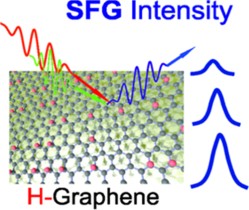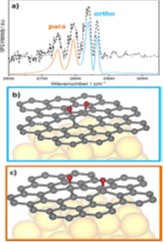
The non-linear laser spectroscopy technique of vibrational sum-frequency generation is surface-selective, making it an ideal tool to investigate graphene and its derivatives, as graphene inherently is one (or two?) large surface(s). Two laser beams are incident on a surface, the first of which is an IR beam which is (ideally) in resonance with a vibration at the surface, the second (the VIS beam, though it is tyipcally at 800nm on many SFG experiments) is used to up-covert the vibrationally excited molecule. Upon relaxation, the molecule emits a photon at the sum of the frequencies of the two incoming molecules, hence SFG spectroscopy.

We have succesfully employed SFG to detect trace impurities of PMMA from polymer-transferred graphene, have functionalised graphene with phenyl rings and detected these phenyl groups (trees) and even quantified the surface coverage. More recently, we have identified the ortho- and para-hydrogenation of graphene by spectroscopically anlaysing the C-H stretches in hydrogenated graphene, and we are currently studying the ultra-fast energy transfer through those bonds.